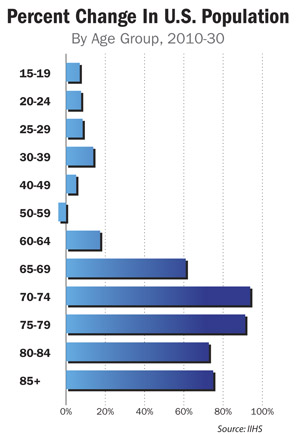The U.S. population is aging, but despite statistics that older drivers have higher claim rates, the overall number of collision claims is not expected to increase, says the Insurance Institute of Highway Safety.
In a recently released report, the IIHS says an analysis by the Highway Loss Data Institute (HLDI) shows there are factors that will counter the negative impacts of an aging population between now and 2030.
 People in their 70s and 80s have a higher claim rate than those in their 50s and 60s, IIHS says, but the percentage of older drivers is “predicted to remain relatively small” in relation to the number of overall drivers.
People in their 70s and 80s have a higher claim rate than those in their 50s and 60s, IIHS says, but the percentage of older drivers is “predicted to remain relatively small” in relation to the number of overall drivers.
In addition, while there may be more drivers 70 and older, there will be a corresponding decrease in drivers under 30 “who have the highest claim rates of all.”
“Age-related impairments can affect a person's driving, so concern over the country's changing demographic make-up is understandable,” says HLDI Vice President Matt Moore in a statement. “However, when we look at the overall number of claims, this isn't the looming crisis some have made it out to be.”
Crashes by elderly drivers may catch headlines, but it doesn't mean the elderly are causing more accidents, the report asserts.
Per mile driven, the report says, rates of fatal crashes and all police-reported crashes start to rise around age 70. However, the crash rates have fallen faster in recent years for older drivers than for middle-age drivers.
The rate of fatal crashes per licensed driver 70 and older fell 37 percent from 1997 to 2008, according to an IIHS 2010 study, the report notes.
One reason given for this trend is that older drivers “tend to limit the amount they drive, particularly at night or in other situations they find challenging.”
Predictions are that the total driving-age population is expected to rise to 291 million by 2030, with the demographics skewing older. However, not all those of driving age will become licensed drivers, the report notes. Statistics indicate that for each demographic group, as it ages, the number of drivers increases, peaking at 60-64, then begins to decline.
Claim frequency is highest for drivers 15-19, at nearly 70 percent above average. The frequency rate declines with age, reaching its lowest level at 60-64. That rate then begins to rise “but never approaches the level of teenagers.”
Over the next two decades, claim frequency is expected to be flat hovering around 6.12 and 6.16 claims per 100 insured vehicle years.
“In absolute numbers, there still may be more crashes in the future, but that is because more people will be driving, not because more of the drivers are older,” says the report.
Want to continue reading?
Become a Free PropertyCasualty360 Digital Reader
Your access to unlimited PropertyCasualty360 content isn’t changing.
Once you are an ALM digital member, you’ll receive:
- Breaking insurance news and analysis, on-site and via our newsletters and custom alerts
- Weekly Insurance Speak podcast featuring exclusive interviews with industry leaders
- Educational webcasts, white papers, and ebooks from industry thought leaders
- Critical converage of the employee benefits and financial advisory markets on our other ALM sites, BenefitsPRO and ThinkAdvisor
Already have an account? Sign In Now
© 2024 ALM Global, LLC, All Rights Reserved. Request academic re-use from www.copyright.com. All other uses, submit a request to [email protected]. For more information visit Asset & Logo Licensing.








